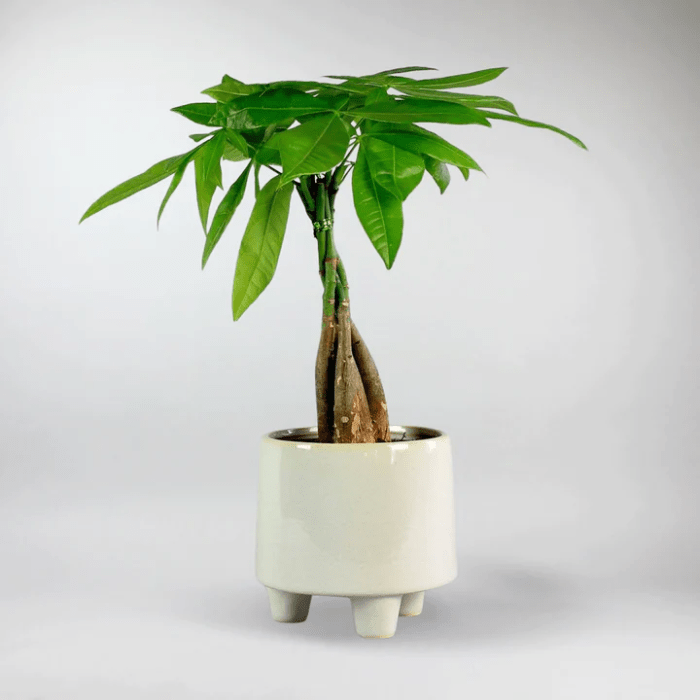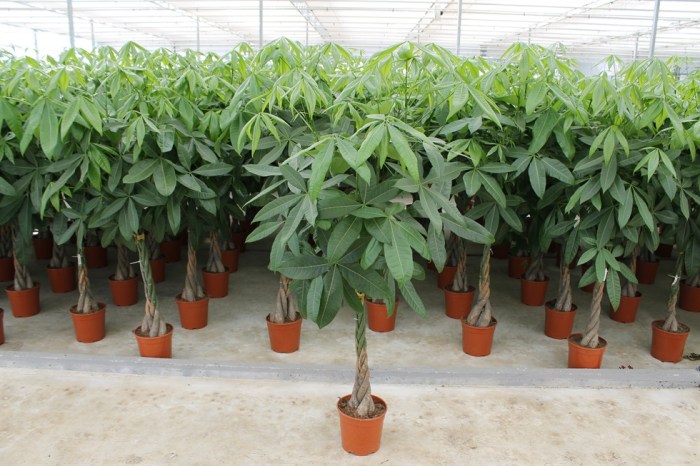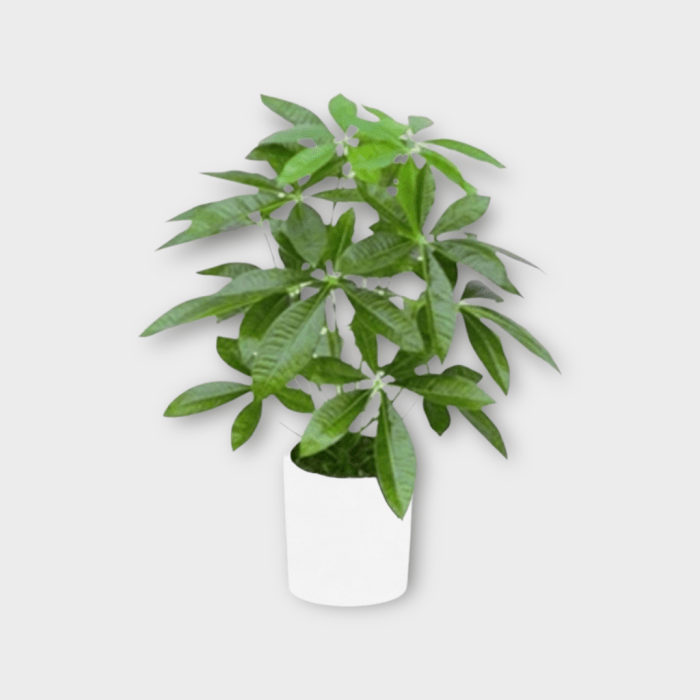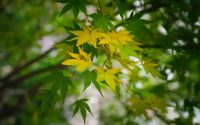Where to Buy a Money Tree Plant
Plant Varieties and Selection: Where To Buy A Money Tree Plant

Where to buy a money tree plant – Choosing the right money tree (Pachira aquatica*) variety can significantly impact its appearance and the ease of its care. Different varieties boast unique leaf shapes, sizes, and growth habits, requiring slightly different approaches to cultivation. Getting this right from the start is key to a thriving, lush plant.
Money Tree Varieties and Their Characteristics
Several variations of thePachira aquatica* exist, though the differences are often subtle. Many are simply variations in the braiding or shaping of the trunks, rather than distinct botanical varieties. However, some differences in leaf size and shape can be observed. The most common types available commercially tend to be those with variations in trunk braiding and the number of trunks included.
These variations are primarily aesthetic, influencing the overall look of the plant rather than its fundamental care requirements.
- Standard Money Tree: Typically features multiple braided trunks, varying in thickness and height. Leaves are palmate, meaning they have five to seven leaflets radiating from a central point. These leaves are usually a vibrant, deep green. This variety is the most commonly found and relatively easy to care for. Ideal growing conditions include bright, indirect light, well-draining soil, and moderate watering.
- Single-Trunk Money Tree: A less common variation, featuring a single, unbraided trunk. The leaf characteristics remain the same as the standard variety. This option might appeal to those who prefer a more minimalist aesthetic. Care requirements are essentially identical to the standard money tree.
- Dwarf Money Tree: This variety, while less readily available, stays smaller and more compact than the standard money tree. The leaves maintain the same palmate structure but are proportionally smaller. These need similar care but might require more frequent watering due to the smaller root system and quicker drying of soil. It’s important to prevent overwatering, as this could lead to root rot.
Comparative Analysis of Money Tree Varieties
While significant differences between money tree varieties are mainly aesthetic, understanding these subtle variations can help you choose a plant that best suits your space and style. The standard braided money tree is generally the most widely available and adaptable. The single-trunk version offers a different visual appeal, and the dwarf variety is a good option for those with limited space.
All varieties, however, share similar fundamental care needs.
Care Requirements for Different Money Tree Varieties
The core care requirements remain consistent across money tree varieties, focusing on light, watering, and fertilization. Slight adjustments may be needed based on the size and growth habit of the specific variety.
- Light: All money tree varieties thrive in bright, indirect light. Avoid direct sunlight, which can scorch the leaves. A spot near an east- or west-facing window is usually ideal.
- Watering: Allow the top inch or two of soil to dry out between waterings. Overwatering is a common problem, leading to root rot. Adjust watering frequency based on the size of the pot and the environmental conditions.
- Fertilizer: Feed your money tree with a balanced liquid fertilizer every 2-4 weeks during the growing season (spring and summer). Reduce or cease fertilization during the dormant season (autumn and winter).
Cost Considerations and Budgeting

Right, so you’re chuffed about getting a money tree, but before you splash the cash, let’s get a handle on the costs involved. It’s not just the initial outlay, you know; there’s ongoing maintenance to consider. This section breaks down the price ranges and helps you budget effectively for your leafy new friend.Price ranges for money trees vary wildly, depending on a few key factors.
Think of it like buying a car – a banger is cheaper than a top-of-the-range model. Similarly, a small, young money tree will cost considerably less than a mature, larger specimen.
Price Ranges for Money Tree Plants
The cost of a money tree is heavily influenced by its size, age, and the specific variety. A small, young plant (around 6-12 inches tall) might set you back anywhere from £10 to £25. A medium-sized plant (12-24 inches) could cost between £25 and £50, while larger, more mature plants (over 24 inches) can easily reach £50-£100 or even more, especially for rare or uniquely shaped varieties.
These prices are estimates, and you might find variations depending on the retailer and location.
Factors Influencing Money Tree Costs
Several factors contribute to the final price tag. Size is obviously a big one; larger plants require more time and resources to grow, hence the higher cost. Age is another – older, established plants are more expensive because they’ve already undergone significant growth and development. Rarity plays a part too; unusual varieties or those with unique characteristics (like unusually braided trunks) command higher prices due to their limited availability.
The pot and the overall presentation can also add to the cost.
Budgeting for Your Money Tree
Planning a budget is crucial to avoid any nasty surprises. Here’s a simple worksheet to help you:| Item | Estimated Cost (£) | Notes ||————————–|———————-|————————————————————————|| Plant Purchase | | Varies based on size and variety (see price ranges above) || Potting Soil | 5-10 | Depends on pot size; good quality soil is essential || Fertilizer | 5-10 | A slow-release fertiliser is ideal for money trees.
|| Other Supplies (e.g., pebbles for drainage) | 2-5 | Consider the pot size and drainage requirements. || Total Estimated Cost | | Sum of all costs |
Visual Comparison: Small vs. Large Money Tree
Imagine two scenarios: Scenario 1: Small Money Tree* A small money tree (6-12 inches) costs approximately £15.
Potting soil
£5
Fertilizer
Looking for a thriving money tree plant? Many nurseries and online retailers carry them, but for a truly meaningful gesture, consider planting a tree in memory of a loved one in Colorado. You can explore options to plant a tree in memory colorado and then add a beautiful money tree to your home, symbolizing growth and prosperity.
£5
Total
£25 Scenario 2: Large Money Tree* A large money tree (over 24 inches) costs approximately £75.
Potting soil
£10 (larger pot needed)
Fertilizer
£10 (larger quantity needed)
Total
£95This comparison clearly illustrates the significant difference in initial investment between a small and a large money tree. Remember, this is just the initial cost; ongoing care, such as repotting and occasional fertilising, will incur additional, albeit smaller, expenses over time.
Post-Purchase Care and Maintenance

Right, so you’ve bagged yourself a cracking money tree – chuffed to bits, I bet! Now, the real work begins. Looking after this little dude isn’t rocket science, but a bit of TLC will keep it thriving and looking its best. Ignoring it will, erm, not end well.
Repotting a Money Tree Plant
Repotting your money tree is crucial for its long-term health and growth. A pot that’s too small will restrict root development, leading to stunted growth and general unhappiness for your plant. The ideal time to repot is during the spring or early summer, when the plant is actively growing.
- Choose a pot only slightly larger than the current one – about 2 inches bigger in diameter is usually sufficient. Avoid drastically increasing the pot size, as this can lead to overwatering issues.
- Select a well-draining potting mix. A standard potting mix amended with perlite or coarse sand will work a treat.
- Gently remove the money tree from its current pot. Try to loosen the root ball to avoid damaging the roots. If the roots are tightly bound, carefully tease them apart a bit.
- Place a layer of fresh potting mix in the bottom of the new pot. Position the money tree in the centre, ensuring the top of the root ball is level with the rim of the pot.
- Fill the pot with the remaining potting mix, gently firming it around the base of the plant. Avoid compacting the soil too tightly.
- Water thoroughly after repotting, allowing excess water to drain completely.
Common Problems and Solutions
Let’s be honest, even the most seasoned plant parent faces a few hiccups. Here are some common issues and how to sort them:
- Yellowing Leaves: This can indicate overwatering, underwatering, or nutrient deficiencies. Check the soil moisture; if it’s soggy, reduce watering. If it’s dry, water thoroughly. A balanced liquid fertiliser during the growing season can help with nutrient deficiencies.
- Leaf Drop: Sudden leaf drop often signals a dramatic change in environment – like a sudden temperature drop or a move to a drafty spot. Gradually acclimatise your plant to any changes in its environment. Also check for pests.
- Pest Infestations: Mealybugs and spider mites are common pests. Inspect your plant regularly and treat infestations promptly with insecticidal soap or neem oil.
- Root Rot: This nasty problem arises from overwatering. The roots become mushy and brown. If you suspect root rot, you might need to repot, removing any affected roots.
Propagating a Money Tree from Cuttings, Where to buy a money tree plant
Propagating your money tree is a brilliant way to get more plants without breaking the bank. It’s surprisingly straightforward.
- Take a 4-6 inch cutting from a healthy stem, ensuring it has at least two nodes (the points where leaves or branches emerge).
- Remove the lower leaves from the cutting to prevent rot.
- Dip the cut end in rooting hormone (optional, but it helps!).
- Plant the cutting in a well-draining potting mix or place it in a glass of water.
- Keep the cutting moist but not soggy. Roots should develop in a few weeks to a couple of months.
- Once roots have formed, plant the cutting in its own pot.
Watering a Money Tree Plant
Imagine a visual representation: The pot is slightly raised on a saucer. The soil looks slightly damp, not soaking wet or bone dry. Underwatering: The soil is completely dry, cracked, and the leaves are drooping and brittle. Overwatering: The soil is waterlogged, with standing water in the saucer. The leaves are yellowing and may be dropping.
The stems might feel soft or mushy. The ideal watering technique involves allowing the top inch or two of soil to dry out before watering again thoroughly, allowing excess water to drain away completely. Avoid letting the plant sit in standing water.
FAQ Summary
How often should I water my money tree?
Water your money tree thoroughly when the top inch of soil is dry. Overwatering is a common problem, so it’s better to underwater slightly than overwater.
What type of soil is best for a money tree?
A well-draining potting mix is crucial. A mix designed for succulents or cacti often works well.
How much sunlight does a money tree need?
Bright, indirect sunlight is ideal. Avoid direct sunlight, which can scorch the leaves.
Can I propagate my money tree?
Yes, you can propagate money trees from stem cuttings. Make sure the cutting has a few leaves and allow it to callous before planting in moist soil.


